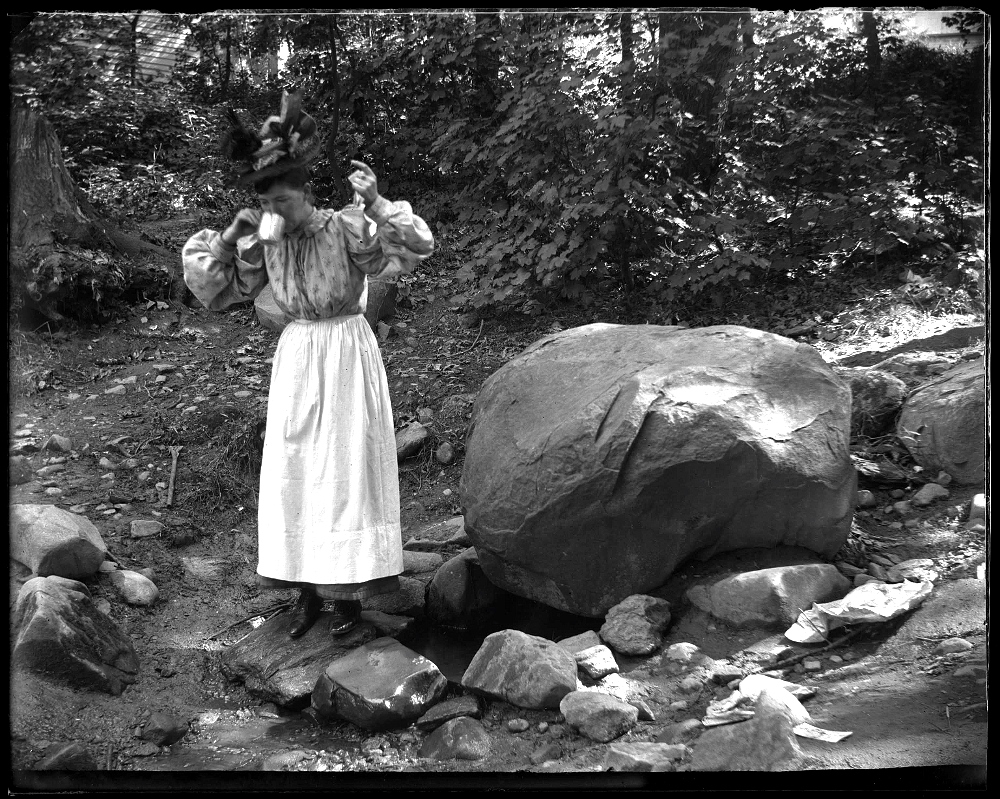
A woman drinks at Carman Spring, on West 175th Street east of Amsterdam Avenue, New York City, c. 1897–1902. Photo: James Reuel Smith/New York Historical Society.
- Today in the expenditure of effort: one reason serialization has become so popular, Juliet Lapidos, is that it curtails the reader’s (or viewer’s) setup time, encouraging a kind of economy in entertainment: “The most demanding part of any narrative art form is the beginning, when everything—the style, the plot, the characters, perhaps even the universe in which the characters operate—is new … Series minimize that period of difficulty relative to the total experience. You do the work once, and then you’re free and easy … For the last twelve years, I’ve been addicted to serial novels.”
- Gregory Woods’s new book, Homintern, is a history of gay conspiracy in the arts—a history that, as Caleb Crain writes, requires some paradoxical thinking to address properly: “Homintern was a portmanteau word, a mash-up ofComintern, the name of the international communist organization that flourished between the two world wars, andhomosexual. It referred, originally in jest, to the notion that a clique of gay men and (in smaller numbers) lesbian women controlled the arts world from behind the scenes, giving undue preference to the work of their lovers, ex-lovers and would-be lovers, and skewing taste away from the ‘natural’ and ‘wholesome’ … [Woods] rightly debunks the idea of a Homintern, pointing out that it’s unfair to single out gay men for mixing romance and art—‘as if,’ he writes, ‘heterosexual people never dedicate their books to their lovers or spouses’ … Woods then proceeds, however, to devote the bulk of his book to recounting, and even celebrating, links between gay men in the arts that were half hidden and often sexual in nature—the same links that he thinks it would be unjust, if not paranoid, to make too much of.”
- Easy advice: when you’re feeling down, look at a painting of a Russian person’s face. You’ll be surprised, delighted, perhaps even moved. They’re formidable faces. Jenny Uglow is especially fond of the portraitist Ilya Repin, whose work is well represented in a new show at the National Portrait Gallery: “I found these serious, unsmiling portraits astonishing. They feel governed by the belief that a portrait—like an intense conversation between artist and sitter—can bring us closer to its subject than any new-fangled photograph could do … There is humor in Repin’s portraits as well as empathy and understanding. Great warmth, for example, in his sexy, self-possessed pianist Sophie Menter, Liszt’s brilliant protégé; and a keen wit in his classic swagger-portrait of the salonnière Baroness Varvara Ikskul von Hildenbandt with her wickedly pointed hat and veil. At once bold and restrained, this is painted with such enjoyment that we can almost feel the weight of the locket chain round her arm and touch the gathers of her scarlet blouse and sweeping skirt.”
- A century ago, James Reuel Smith could still recall the days when a New Yorker might reasonably expect to stumble upon a natural spring within city limits: “In the days, not so very long ago, when nearly all the railroad mileage of the metropolis was to be found on the lower half of the Island, nothing was more cheering to the thirsty city tourist afoot or awheel than to discover a natural spring of clear cold water, and nothing quite so refreshing as a draught of it.”(His book Springs and Wells of Manhattan and the Bronx: New York City at the End of the Nineteenth Centurycontains an abundance of photographs of refreshed spring-sippers.)
- It’s about time someone wrote a history of oral histories that isn’t also an oral history: “The term oral historyhas been around for decades, though, early on, it was primarily the domain of folklorists, archivists, and academics. In the 1930s, the Federal Writer’s Project, funded by the New Deal, gathered the first-person narratives of former slaves, still alive in America; people who had traveled West in covered wagons; and others with interesting stories, say, about meeting Billy the Kid or surviving the Great Chicago Fire of 1871 … Some early guidelines, penned by longtime oral historian Willa Baum, in her book Oral History for the Local Historical Society, included tips that remain relevant even now: ‘An interview is not a dialogue … Ask one question at a time … Ask brief questions … Don’t let periods of silence fluster you … Try to avoid “off-the-record” information … Don’t switch the recorder off and on … Don’t use the interview to show off your knowledge, vocabulary, charm or other abilities.’ ”

 Gods of War
Gods of War  Q&A with tendercare founder and CEO Shauna Sweeney
Q&A with tendercare founder and CEO Shauna Sweeney  Google Pixel Buds Pro 2: $40 off at Amazon
Google Pixel Buds Pro 2: $40 off at Amazon  Best robot vacuum deal: Get the Roborock Q5 Max for 53% off at Amazon
Best robot vacuum deal: Get the Roborock Q5 Max for 53% off at Amazon  Mary Shows Up
Mary Shows Up 







